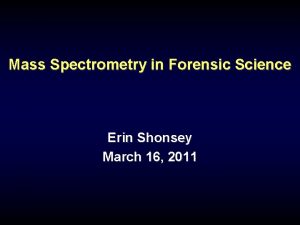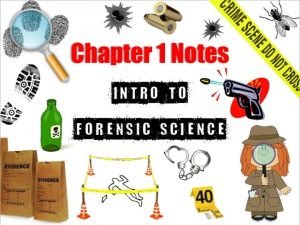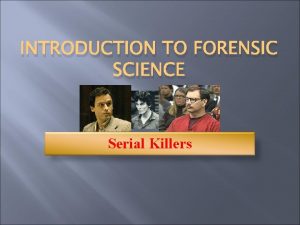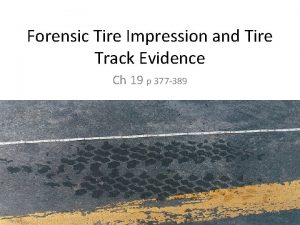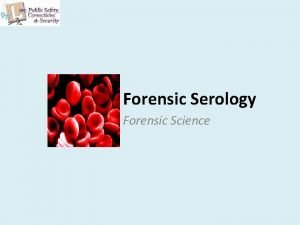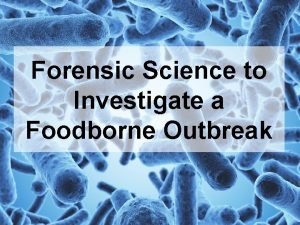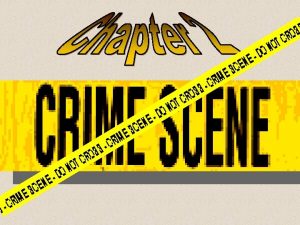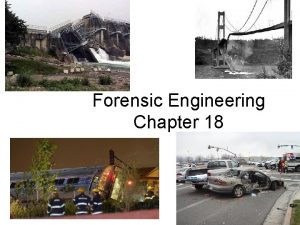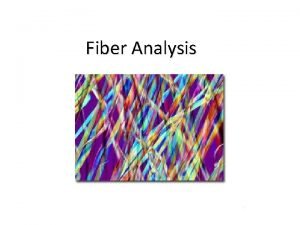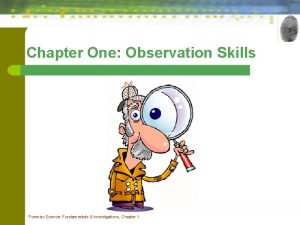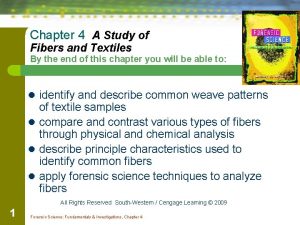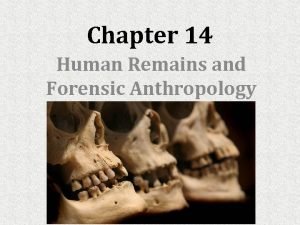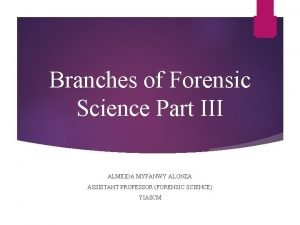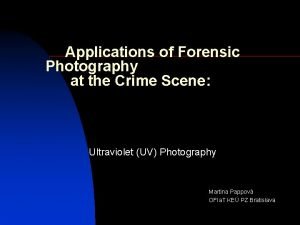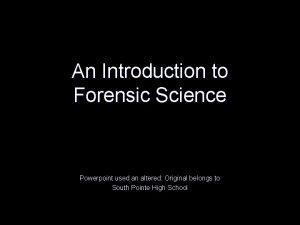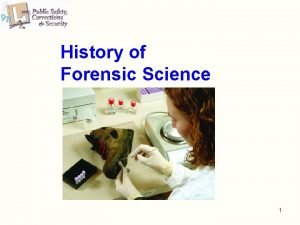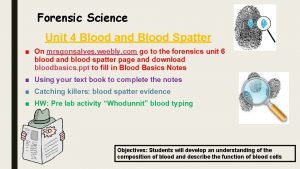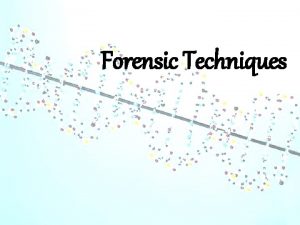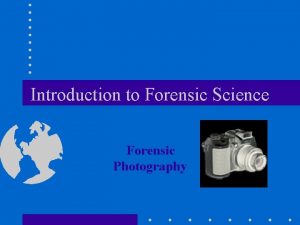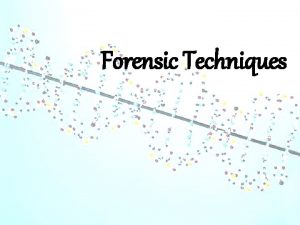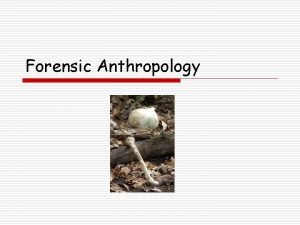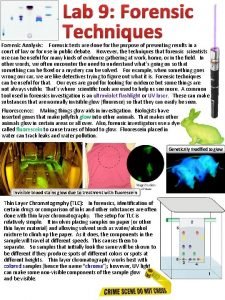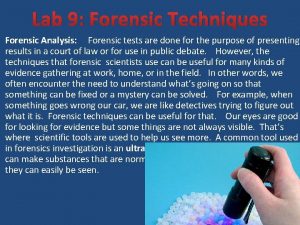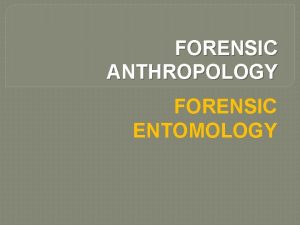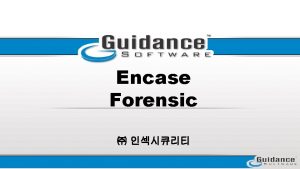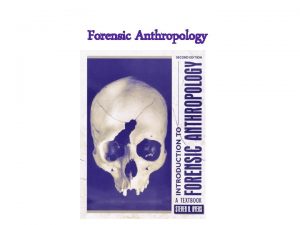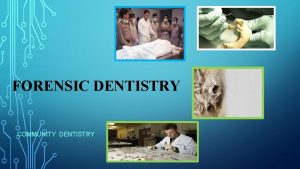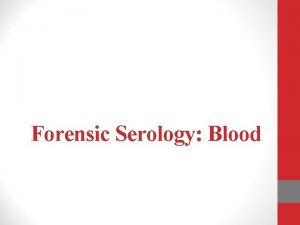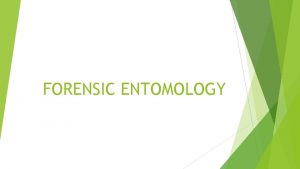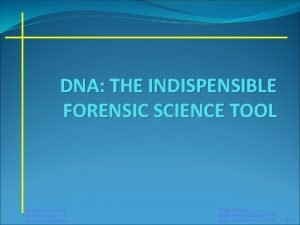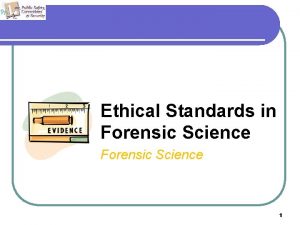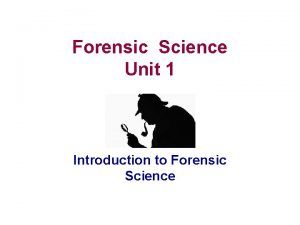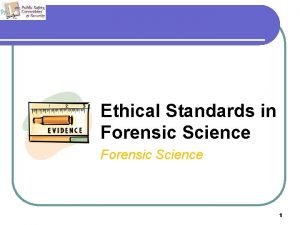What is Forensic Science The application of science




























- Slides: 28




What is Forensic Science? The application of science to the criminal and civil laws that are enforced by police agencies in a criminal justice system

*Third century Chinaearliest records of applying forensics to solve criminal cases *Manuscript -Yi Yu Ji (“A Collection of Criminal Cases”) *Chinese were first to recognize fingerprints for identification

Marcello Malpighi *Professor of Anatomy in Italy *1686 -First recorded notes about fingerprint characteristics *Didn’t acknowledge fingerprints as a means of identification

Carl Wilhelm Scheele *Swedish Chemist *In 1775 he devised the first successful test for detecting arsenic in corpses

Francois-Emanuel Fodéré *French Physician *In 1798 wrote “A Treatise on Forensic Medicine and Public Health” *First treatise on forensic science *Had a greater understanding of workings of the body

Valentin Ross *German Chemist *In 1806 discovered a more precise method for detecting small amounts of arsenic in walls of victims stomach

SELF-CHECK QUESTION

Who was the first individual to make the first test to detect arsenic in dead people? Carl W. Scheele

Mathieu Orfila *Spaniard *Father of Forensic Toxicology *In 1814 he published the first scientific treatise on the detection of poisons and their effects on animals

Alphonse Bertillon *Applied Anthropology and Morphology to the first system of personal identification in 1879 *Known as Anthropometry *Involved taking a series of body measurements to tell one person from another *Replaced by fingerprinting in early 1900’s Father of Criminal Identification




William Nichol -Invented polarizing microscope -First procedures for microscopic detection of sperm First Test for Hemoglobin -1853 Henri-Louis Bayard First test for blood -1863 Toxicological evidence first used in trial -1839 -Scottish Chemist that testified on detection of arsenic in a victim New Science of Photography - 1850’s & 60’s recorded images of prisoners and crime scenes James Marsh

Thomas Taylor *US microscopist *Suggested that fingerprints could be used as a means of ID Henry Faulds *3 yrs later Scottish Physician published a paper that supported Taylor’s findings

Francis Henry Galton *Englishman *First clear study of fingerprints and developed a method of classifying them for filing *Published a book in 1892 called “Finger Prints” *His work is the basis for the finger printing system used now

Who created the first system of personal identification? Alphonse Bertillon

Hans Gross *Public Prosecutor & Judge in Austria *Wrote the first treatise describing the application of scientific fields to criminal investigations *Spent many years studying and developing principles of criminal investigation *Wrote the book “Criminal Investigation” & a forensic journal, that is still used today

*Applied principles of serology, fingerprinting, firearms ID, and questioned document examination to create the Sherlock Holmes fictional series SIR ARTHUR CONAN DOYLE

Dr. Karl Landsteiner *In 1901 discovered that blood can be grouped into catergories: A, B, AB, & O *Professor of Forensic Medicine in Italy Dr. Leone Lattes * In 1915, he created a procedure to determine the blood group of dried blood, which he used in criminal investigations

Albert S. Osborn *In 1910 wrote the first significant text in the field called “Questioned Documents” *Responsible for the acceptance of documents as scientific evidence in courts

Who is the Father of Forensic Toxicology? Mathieu Orfila

Edmond Locard *Educated in Medicine & Law *First to demonstrate how what Gross stated, could be incorporated within a workable crime lab *In 1910 he got the Lyons Police Dept to let him use two attic rooms and assistants to start a police lab *Created “Locard’s Exchange Principle” –cross transfer occurs when two materials come into contact with each other

Army Colonel Calvin Goddard *Refined techniques of firearms examination using the comparison microscope *Technique allows investigators to determine whether a gun has fired a bullet by comparing the bullet with one that has been testfired from the suspect’s weapon

Known as the “Father of Microscopy”, leading expert in microscopy. To the general public, however, he was best known for his work on the Shroud of Turin. Mc. Crone microscopically examined the physical forensic evidence: hairs, fibers, blood, etc. that led to the conviction of Wayne Bertram Williams as the Atlanta child killer
 Pathologist and anthropologist
Pathologist and anthropologist Who is this
Who is this Sola pith hymen
Sola pith hymen Pigment granules in hair
Pigment granules in hair Mass spectrometry in forensic science
Mass spectrometry in forensic science Who established the first workable crime laboratory
Who established the first workable crime laboratory Gil carrillo
Gil carrillo Important people in forensics
Important people in forensics Tire impressions
Tire impressions Importance of forensic serology
Importance of forensic serology Locard's exchange principle
Locard's exchange principle Forensic science foodborne outbreak investigation answers
Forensic science foodborne outbreak investigation answers Definition of forensic science
Definition of forensic science Forensic science begins at the crime scene.
Forensic science begins at the crime scene. Forensic science arson activity
Forensic science arson activity Forensic science chapter 18 review answers
Forensic science chapter 18 review answers Fibers from animals
Fibers from animals Chapter 1 observation skills answers
Chapter 1 observation skills answers Forensic science chapter 4 fibers and textiles
Forensic science chapter 4 fibers and textiles Nibis ballistics definition
Nibis ballistics definition Chapter 14 forensic anthropology
Chapter 14 forensic anthropology Branches of forensic science
Branches of forensic science Ultraviolet photography in forensic
Ultraviolet photography in forensic Introduction to forensic science ppt
Introduction to forensic science ppt What are the three methods of crime scene recording
What are the three methods of crime scene recording Department of forensic science dc
Department of forensic science dc Hans gross forensic science
Hans gross forensic science Valentin ross german chemist
Valentin ross german chemist Serology and bloodstain pattern analysis crossword
Serology and bloodstain pattern analysis crossword




